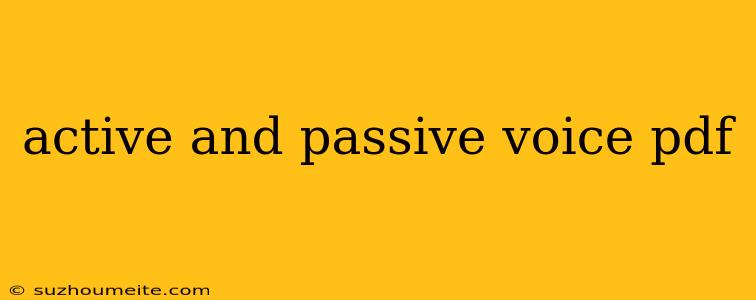Active and Passive Voice: A Comprehensive Guide
The active and passive voice are two distinct grammatical structures used in English to express how actions are performed. Understanding the differences between these voices is crucial for effective communication, particularly in writing. This article will provide a comprehensive guide to active and passive voice, exploring their definitions, usage, and practical applications.
What is the Active Voice?
The active voice is a grammatical construction where the subject of the sentence performs the action. It follows the standard Subject-Verb-Object structure, emphasizing the actor's role in the action.
Example:
- Active voice: The dog chased the ball.
In this example, "dog" is the subject, "chased" is the verb, and "ball" is the object. The dog is actively performing the action of chasing the ball.
What is the Passive Voice?
The passive voice is a grammatical construction where the subject is acted upon, rather than performing the action. It uses a form of the verb "to be" followed by the past participle of the main verb.
Example:
- Passive voice: The ball was chased by the dog.
In this example, "ball" is the subject, but it is not actively performing the action. Instead, it is being acted upon by the dog, who is now the object of the preposition "by."
When to Use Active Voice
The active voice is generally preferred in writing for several reasons:
- Clarity and Conciseness: Active voice is more direct and concise, making the sentence easier to understand.
- Emphasis on the Actor: It highlights the person or thing responsible for the action, emphasizing their agency.
- Stronger Tone: Active voice often conveys a more forceful and authoritative tone.
When to Use Passive Voice
While the active voice is preferred in most cases, there are instances where the passive voice can be more appropriate:
- When the Actor is Unknown or Unimportant: When the person or thing performing the action is unknown or unimportant, the passive voice can be used to focus on the action itself.
- To Emphasize the Recipient of the Action: In situations where the receiver of the action is more important than the performer, the passive voice can be used to highlight their role.
- To Avoid Personal Pronouns: When you want to maintain an objective tone, the passive voice can be used to avoid personal pronouns.
- To Vary Sentence Structure: Using the passive voice occasionally can add variety to your writing.
Recognizing Active and Passive Voice
Here are some tips for recognizing the active and passive voice:
- Look for the Subject: Identify the person or thing performing the action.
- Check for "by" or "by someone/something": The presence of a prepositional phrase starting with "by" often indicates a passive voice sentence.
- Analyze the Verb: If the verb is in a form of "to be" followed by a past participle, it is likely in the passive voice.
Example of Active and Passive Voice
Active Voice: The team scored the winning goal. Passive Voice: The winning goal was scored by the team.
In the active voice sentence, the subject is "team," and it performs the action of scoring. In the passive voice sentence, the subject is "winning goal," and it is acted upon by the team.
Conclusion
Understanding the active and passive voice is crucial for writing clear, concise, and effective communication. The active voice is generally preferred for its clarity and emphasis on the actor, while the passive voice has its specific uses in certain situations. By understanding the nuances of these grammatical structures, you can choose the voice that best suits your purpose and enhance the overall quality of your writing.
